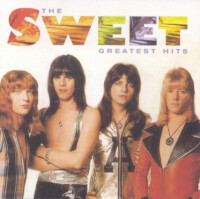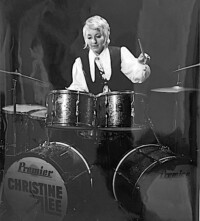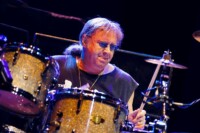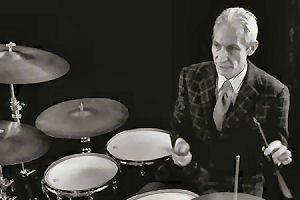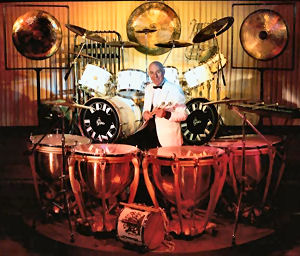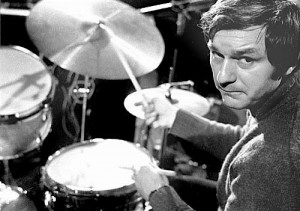 Daniel Humair was born in Zurich on May 23rd, 1938 and he is famous not simply for being a drummer, composer and arranger, he’s also an exceedingly accomplished painter (he describes his own art as ’Figurative Abstract’) and in the past he’s even been something of an inventor. For the purposes of this edition of ‘Groovers and Shakers’ though, he’s famous for being the first drummer from Continental Europe to seriously compete with the very best American and British players.
Daniel Humair was born in Zurich on May 23rd, 1938 and he is famous not simply for being a drummer, composer and arranger, he’s also an exceedingly accomplished painter (he describes his own art as ’Figurative Abstract’) and in the past he’s even been something of an inventor. For the purposes of this edition of ‘Groovers and Shakers’ though, he’s famous for being the first drummer from Continental Europe to seriously compete with the very best American and British players.
His musical career began with him taking up firstly the clarinet, then drums, around the age of seven, whereupon he went on to win jazz competitions in Zurich in his teens. When he was 14 he really wanted to play Dixieland jazz, a musical genre which he mostly taught himself, and which he considers himself to be something of an expert, although these days he prefers a cooler style.
Daniel was able to listen to bebop which was imported to Europe by the thousands of GI’s based in the UK, on the radio. However living in Switzerland he didn’t have access to records although musical ‘scores’ were available for ‘West Coast’ music. So from an early age he was into the coolest of American drummers including Big Sid Catlett, Max Roach, Shelly Manne, Roy Haynes, Stan Levy, and Mel Lewis. However he is of the opinion that it was Shelly Manne who had the most influence on his playing style in his formative years. He started out playing dance music and was introduced to the playing of Philly Jo Jones when he was working in Sweden in 1957. Not long after this he discovered Elvin Jones and this started him on the way to really modern drumming and encouraged him to move to Paris.
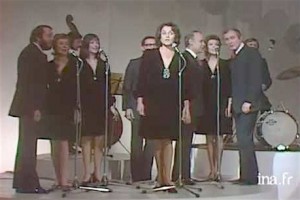 Like a great many European musicians, he found his way to Paris to make a living in ‘The City of Lights’ which was the place to go to play with famous, self-exiled American jazz musicians. At 20 years old he played with Lucky Thompson at a club called “Le Chat qui Péche” after which Daniel Humair became the guy Americans wanted to work with when they came to Europe without a drummer. Jazz giants like Stan Getz, Dizzie Gillespie, Gerry Mulligan, Dexter Gordon, and Lee Konitz all requested his presence on their gigs in Europe.
Like a great many European musicians, he found his way to Paris to make a living in ‘The City of Lights’ which was the place to go to play with famous, self-exiled American jazz musicians. At 20 years old he played with Lucky Thompson at a club called “Le Chat qui Péche” after which Daniel Humair became the guy Americans wanted to work with when they came to Europe without a drummer. Jazz giants like Stan Getz, Dizzie Gillespie, Gerry Mulligan, Dexter Gordon, and Lee Konitz all requested his presence on their gigs in Europe.
Daniel was considered to be one of the best drummers in the world although for some reason he seems to have been ridiculed by his contemporaries for playing with ‘The Swingle Singers’. This vocal group was hugely popular in the mid-sixties interpreting Bach concertos and the like and Daniel simply played jazz rhythms behind their vocals. The material they chose to sing were pieces like Bach’s “Air on a G string” and these people were something of a stepping-stone for Daniel Humair as far as playing in America was concerned and, since he was touring there a great deal during his stint with them, he was able to sit in with a lot of people including Cannonball Adderley and Bill Evans.
I met him first in 1966 when I was playing with a very successful French singer called Richard Anthony and living in France and we frequently bumped into one another at Music Trade Shows after that. In 1967 he began to play with violinist Jean Luc Ponty and in that same time frame saxophonist Phil Woods who had emigrated to Paris. Daniel Humair became the drummer for Woods’ ‘European Rhythm Machine’. He stayed with the band for four years until his next venture which was a trio with Gordon Beck and Ron Mathewson.
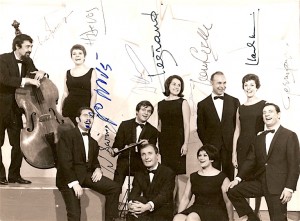 Daniel played Asba, Sonor, Gretsch, Hayman and there’s a picture of him with Pearl drums. And he was responsible for various innovations in the drum world. He certainly popularised the 18” diameter bass drum and the ‘Russian Dolls’ nesting set and Caroline bass pedal (named after his daughter) while he was with Asba. Daniel confided in me that 18” bass drums only sounded right to him if the beater struck the head way above the centre spot. He wanted it to sound like a low tom. He also had something to do with ASBA’s foot-operated floor tom which was nowhere near as sophisticated as others but in a typical Citroen 2CV way it worked. A pedal was attached by a webbing strap to a rubber-ended sprung plunger fixed inside the drum which pressed up against the centre of the underside of the batter head thereby raising the pitch as the pedal was depressed. The ‘Be-Bop’ (aka Russian Dolls) drum kit he had a hand in, was also flawed as far as Daniel was concerned. He once told me you couldn’t expect the inherent resonance of any drum to survive its shell being cut into two than clipped back together.
Daniel played Asba, Sonor, Gretsch, Hayman and there’s a picture of him with Pearl drums. And he was responsible for various innovations in the drum world. He certainly popularised the 18” diameter bass drum and the ‘Russian Dolls’ nesting set and Caroline bass pedal (named after his daughter) while he was with Asba. Daniel confided in me that 18” bass drums only sounded right to him if the beater struck the head way above the centre spot. He wanted it to sound like a low tom. He also had something to do with ASBA’s foot-operated floor tom which was nowhere near as sophisticated as others but in a typical Citroen 2CV way it worked. A pedal was attached by a webbing strap to a rubber-ended sprung plunger fixed inside the drum which pressed up against the centre of the underside of the batter head thereby raising the pitch as the pedal was depressed. The ‘Be-Bop’ (aka Russian Dolls) drum kit he had a hand in, was also flawed as far as Daniel was concerned. He once told me you couldn’t expect the inherent resonance of any drum to survive its shell being cut into two than clipped back together.
In his time with Sonor a few years later he was heavily involved in the development of their sophisticated single-post footpedal, which along with Asba’s Caroline, is considered to be the sine-qua-non of footpedals – even, it seems by the Americans who know a thing or two about making bass drum pedals. The Sonor one has a single post, an eccentric action and a one-piece footplate with an optional felt or wooden-sided beater and an adjustable weight inside to change the balance of the beater. Both it and the ASBA pedal had leather straps although the French pedal had a piece of webbing attached to the heelplate to join it to the stool.
As I said, even though he certainly played drums made on the European mainland ie Asba and Sonor. he was also a Hayman endorser and in their catalogue of the time, and perhaps in keeping with the marques’ bang up-to-date, cutting edge image, he had become more hip and had adopted the Anglo-Saxon diminutive and was named in the catalogue as ‘Danny’ Humair. I’m not sure whose idea that was but my guess is that Ivor Arbiter may have had a hand in it.
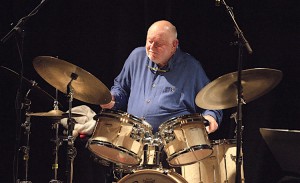 Nowadays Daniel is back playing Sonor with an interesting set up: 16 x 14 and 14 x 14 toms on his left then with two mounted toms (larger on his right) and still with his trademark 18” bass drum which these days measures 15” deep. He appears to be playing K. Zildjian cymbals with an 18“ heavy ride and an 18” heavy crash and 12” heavy hi hats, plus a home-made 16” Flat ride. He wants his bass drum to sound like a lower pitched extension of his toms and has a very interesting style because he plays with his hands as a right hander but bass with his left foot and hi hat with his right.
Nowadays Daniel is back playing Sonor with an interesting set up: 16 x 14 and 14 x 14 toms on his left then with two mounted toms (larger on his right) and still with his trademark 18” bass drum which these days measures 15” deep. He appears to be playing K. Zildjian cymbals with an 18“ heavy ride and an 18” heavy crash and 12” heavy hi hats, plus a home-made 16” Flat ride. He wants his bass drum to sound like a lower pitched extension of his toms and has a very interesting style because he plays with his hands as a right hander but bass with his left foot and hi hat with his right.
I haven’t seen any evidence of Daniel Humair crossing over to the ‘dark side’ and playing rock music but having seen his discography which still details at least one album a year since the very early sixties, it doesn’t look like he ever had to! He even composed scores for films like the tantalisingly named: “Une Sale Affaire” and Marlon Brando’s “Last Tango in Paris”. As befits his heritage, when I first saw him around 1962 I recall he looked the epitome of European cool and if he didn’t have a packet of Gaulloise in his top pocket he certainly should have done.
He says he’s played with everyone who came through Paris with the exception of Miles Davis and Sonny Rollins. Daniel also says he’s played more bebop and Modern Jazz than anybody in America – not because he was better than any American simply because he was in Paris at the right time. He certainly has played with some of the jazz greats including Jim Hall, Jean Luc Ponty, Stephane Grapelli and Chet Baker. He went on to play with European artists like saxophone player Michel Portal, and pianist Martial Solal and, as far as I know I think he’s still playing drums although he took up painting in the mid sixties and is still heavily involved with his art. He describes his painting as “Figurative Abstract” and iIt seems his painting has influenced the textures of his drumming! At the beginning of the Millennium he began working on a free-style musical project called ‘Baby Boom’ which features great European players who are considerably younger than him.
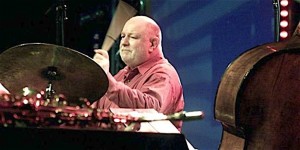 I came upon a quote from Daniel saying:
I came upon a quote from Daniel saying:
“I don’t think we should be overly involved in music when we are musicians. We know what we want to play and have enough technique and chops to be ready. You shouldn’t sit around all day thinking ‘what am I going to play?’ Do I play good, do I play bad? The best way is to be focused on the two hours you’re doing it – and that’s it!”
On another occasion he said:
“Drumming is like speaking, you express your opinion and if somebody is saying things you already know, than it has no interest.”
In 1969 he was voted as having “Talent Deserving Wider Recognition” by Downbeat Magazine and in 1989 he became a “Chevalier of the Ordre des Arts et des Lettres” he was promoted to “Officier” in the order in 1992. This honour is given to people in France like Ray Bradbury and Donald Sutherland “who have significantly contributed to the enrichment of the French cultural inheritance”.
Bob Henrit
May 2017

